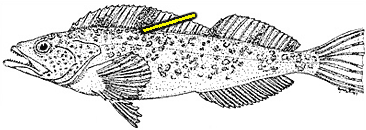
Lingcod Research
Southeast Alaska & Yakutat Commercial Fisheries

Lingcod (Ophiodon elongatus)
ADF&G has been conducting a multi-year tagging study on lingcod in order to investigate movement and exploitation rates in Southeast Alaska. A total of 9,128 lingcod have been tagged opportunistically from 1996 to 2010 along the outer coast of Southeast Alaska. Lingcod were tagged at depths of 4–183 m with approximately 70% tagged at depths greater than 30m and 18% greater than 100 m. Most lingcod were tagged around Cape Edgecumbe, at the Edgecumbe Pinnacle Marine Reserve, or at the Fairweather Grounds. Dart tags were inserted into the flesh on the left side of the body below the front dorsal fin. A total of 455 lingcod tags have been recovered and returned with complete location information.
The maximum distance moved by a recaptured lingcod was 776 km, however, 55% of recaptured lingcod were caught within 10 km of release location. Female lingcod had a greater range of travel than males with females traveling 0.03 to 776.43 km and males 0.05 to 106.88 km. One female lingcod traveled 412 km from the south end of Kruzof Island to British Columbia, three females traveled about 500 km from the Fairweather Grounds to Prince William Sound, and one traveled nearly 800 km in 662 days from the north end of Kruzof Island to Prince William Sound.
Males appeared to be in shallower water and distributed closer to shore than females. Tagged males that were recovered were caught by gear at an average depth of 46 m, whereas females were recovered at an average depth of 86 m. Smaller females, less than 780 mm were found closer to shore in shallower water. Lingcod are distributed by size and sex with smaller lingcod, predominately males, inhabiting shallow nearshore reefs (Cass et al. 1984).
Even though we tagged a similar proportion of males and females (48% vs. 52%), we recovered a larger proportion of females (65% versus 35%). Similar proportions of males and females were recovered by jig or sport gear; however, almost all lingcod recovered by longline gear were females and double the number of lingcod recovered by dinglebar gear were females. Females were selected by longline and dinglebar gear possibly due to depth, fish size, or fishing location.
Maps
Reference
Examination of Lingcod, Ophiodon elongatus, Movements in Southeast Using Traditional Tagging Methods
(PDF 1,213 kB)
Cass, A.J., R.J. Beamish, and M.S. Smith. 1984. Study of the biology of lingcod off the west coast of Vancouver Island, M/V Arctic Harvester, November 22–December 2, 1977. Canadian Data Report Fisheries and Aquatic Sciences461, Ottawa, Canada.
